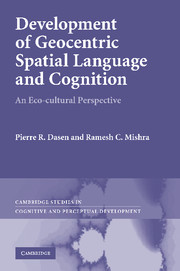Book contents
- Frontmatter
- Contents
- List of figures
- List of tables
- Preface
- Acknowledgements
- Part I Introduction and methods
- Part II Results
- Part III Additional studies
- 10 Spatial language addressed to children
- 11 Geocentric gestures before language?
- 12 Spatial organization schemes
- 13 Neurophysiological correlates of geocentric space
- 14 Geocentric dead reckoning
- Part IV Conclusions
- Appendices
- Bibliography
- Name index
- Subject Index
10 - Spatial language addressed to children
Published online by Cambridge University Press: 02 December 2010
- Frontmatter
- Contents
- List of figures
- List of tables
- Preface
- Acknowledgements
- Part I Introduction and methods
- Part II Results
- Part III Additional studies
- 10 Spatial language addressed to children
- 11 Geocentric gestures before language?
- 12 Spatial organization schemes
- 13 Neurophysiological correlates of geocentric space
- 14 Geocentric dead reckoning
- Part IV Conclusions
- Appendices
- Bibliography
- Name index
- Subject Index
Summary
The first language children hear in this world is the language of their parents, and generally that is the language they first acquire as their mother tongue. Language is largely a product of parent–child interaction, particularly in early years (Bates, Dale, & Thal, 1995; Harris, 1992; Snow, 1995). In later years other influences (e.g. peers, schooling) also shape language development (Bates, 1975). Much research in developmental linguistics has described the manner in which children acquire language and the way in which they grasp the meaning of concepts (Bowerman & Levinson, 2001). While the existence of “motherese” is no doubt universal, there are wide cultural as well as individual differences in its forms (Masataka, 2008).
One way to understand the processes underlying the development of a spatial frame of reference is to analyze the spatial language addressed by adults, especially mothers, to children in early years of life. Such analyses may permit an understanding of the language transmission processes. Given a situation in which mothers find an opportunity to talk to young children about the spatial location of objects or spatial events, it may be assumed that they would use the mode of spatial description predominant in the local context in ways that would be understandable to children. In other words, we assume that mothers will use their preferred spatial FoR in describing objects or situations by tailoring it to the level of understanding of the particular child.
- Type
- Chapter
- Information
- Development of Geocentric Spatial Language and CognitionAn Eco-cultural Perspective, pp. 233 - 241Publisher: Cambridge University PressPrint publication year: 2010

